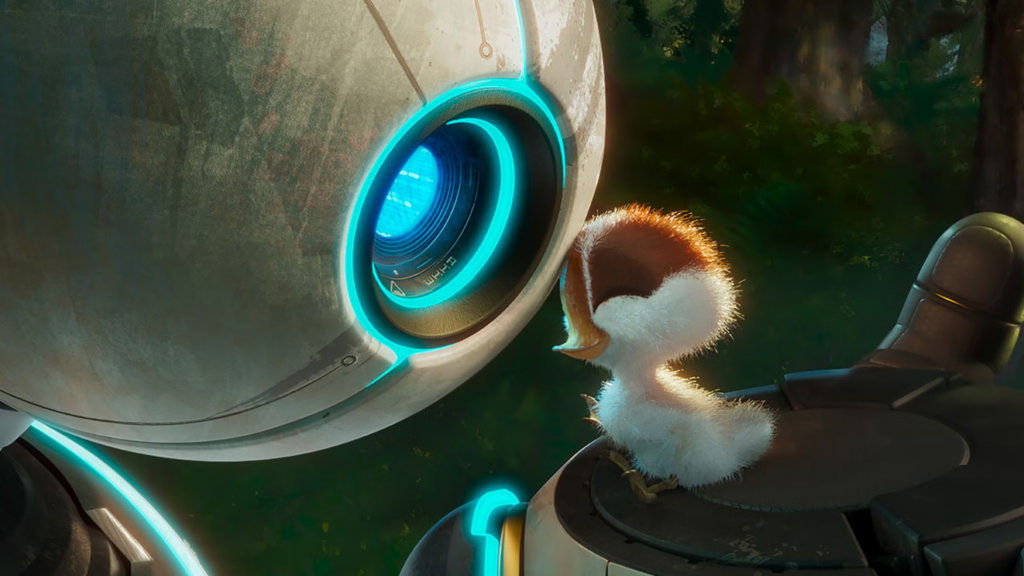A Story of Survival, Curiosity, and Connection with Nature
I chose The Wild Robot because I was drawn to its unique combination of technology and nature. The film, based on the book of the same name by Peter Brown, tells an unusual yet deeply touching story of a robot named Roz who finds herself stranded on a remote island instead of a megacity. She is programmed primary to serve humans, designed exclusively to assist and support them. Her only mission is to find a task and complete it. What makes this story special is how it intertwines themes of survival, ecology, and the interconnection of beings that, at first glance, seem entirely different. Additionally, it teaches us about the importance of ecosystems and our relationships with nature.

The film takes us through Roz’s journey from her arrival on the island to the moment she slowly begins to understand and adapt to the natural world around her. At first, she is just a piece of technology, unaware of her surroundings and entirely unprepared for the harshness of the wilderness. However, through a series of challenges and interactions with the island’s animals, she gradually learns how to survive. This transformation is not just physical, she becomes aware, develops empathy, and starts forming relationships with the creatures around her. I find this particularly important to showcase to children, as they also go through similar realizations and emotions at that stage of life. I was especially intrigued by how the film explores the coexistence of technology and nature. Instead of portraying the classic conflict between the artificial and the organic, The Wild Robot examines the possibility of harmony between these two worlds. Roz does not attempt to dominate nature; instead, she studies it, learns from it, and adapts to its rules. This aspect of the story reminded me of my visit to the CoSA Museum in Graz, where I had the opportunity to see how scientific information can be conveyed through interactive experiences. Just as museum installations allow visitors to learn through hands-on exploration, Roz’s story demonstrates how powerful and effective experiential learning can be. This inspired me to focus my research on children, specifically on nature-based education and outdoor learning environments.
Another part of the story that stayed with me was Roz’s relationship with the island’s animals. At first, they see her as a threat, but through her patience and actions, they come to accept her. Over time, she becomes part of the ecosystem instead of an outsider. One of her most meaningful bonds is with a duckling named Brightbill, whom she rescues and raises as her own. This dynamic adds so much warmth to the story and raises fascinating questions about family bonds that go beyond biology. Reflecting on the structure of the story, I noticed parallels with educational methods I’ve encountered. At the CoSA Museum, for example, visitors can test their knowledge, make decisions, and observe the consequences just as Roz does on the island. Her process of learning through trial and error, experimentation, and reflection is, at its core, what genuine learning looks like. It’s a concept that extends beyond the film, applying to academic research, creative projects, and even personal growth.
One of the most impressive aspects of the film is how it communicates environmental messages without being heavy-handed. you gain an awareness of the fragility of ecosystems and the importance of adaptation. But instead of preaching, the story invites you to form your own conclusions. It reminded me of museum exhibits where visitors are prompted to reflect on their lifestyles and the impact they have on the environment. That kind of self-reflection often inspires meaningful personal change. Ultimately, the message of The Wild Robot is not just about surviving in the wilderness but about finding one’s place in the world, no matter where we come from. It also encourages us, as intellectual beings, to think about how we can help the natural world rather than simply exploit it. The film reminded me of the importance of learning—especially learning through continuous experimentation and hands-on experience.
Working on the Hatched project for Dynamic Media and my experience at the museum have both strengthened my interest in working with children. Seeing how young minds engage with interactive storytelling and experiential education reaffirmed my belief that nature-based learning is crucial in today’s increasingly digital world. Just like Roz, children are in a constant state of exploration, adaptation, and discovery, and it is through such meaningful interactions that they shape their understanding of the world.